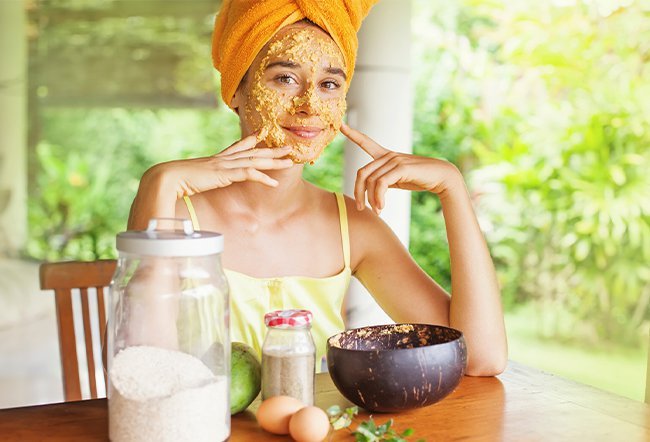How Can I Do a Natural Facial at Home?
8 steps to perform a facial

A facial can be done at home using simple, yet nourishing homemade products. It is important to use clean and sterilized instruments to perform a facial at home to get the best benefits.
You may perform a facial at home with the following 8 steps:
- Cleanse: Cleaning your face to remove makeup or dirt and excess oils from the face is an essential step, to begin with, because a clean face helps pores open, and the skin can absorb products that are to be used in the next step.
- Honey, cold-pressed coconut oil and milk are natural cleansers, and you may choose the product according to your skin type.
- You may use honey if you have oily skin and acne. It cleans off all the oil and acts as an antibiotic against acne.
- Coconut oil and milk can be used on all types of skin. They are highly beneficial for dry skin.
- Take a tablespoon of any of the above ingredients and gently massage your face in a circular motion.
- Rest your face when the product is on for a while and wipe it off with a wet towel.
- Honey, cold-pressed coconut oil and milk are natural cleansers, and you may choose the product according to your skin type.
- Exfoliate: Exfoliation is one of the most important parts of your facial.
- Exfoliation deep cleans the skin, removes all the dead cells and debris, and smoothens the skin.
- It is important to use chemical exfoliants (that contain lactic acid) rather than physical scrubs that may damage the skin. The best exfoliants are curd, fermented rice water, or finely ground oats.
- You may apply some pressure while scrubbing to remove all the debris. However, you must be cautious that excessive scrubbing can damage your skin, resulting in breakouts.
- Steam: Applying steam to the face dilates the pores and removes dirt and grease from the pores.
- Steam plays a role in improving blood circulation and hydrates the skin.
- You must be cautious while using the stem. Using very hot steam or using steam for more than 10 minutes may dry out or burn your skin.
- Extract: Extraction of blackheads and oil clogs is the next essential step that removes all the dirt and oil that lingers within the skin, and it is done with the help of tools.
- Steam softens the skin and enlarges the pores, so it is easy to perform extraction following steam. However, extraction needs good skill, and if done wrong, you may end up with scars on the skin.
- If you are a beginner, it is recommended to avoid performing extraction with tools. Exfoliation, peels, and masks help remove some of the dirt and blackheads.
- Massage: Exfoliation, steam, and extraction make your skin red and sore. With gentle massage, the skin regains its strength that is lost when you use harsh products and heat.
- Apply comfortable pressure while massaging because it improves blood circulation and reduces stress, wrinkles, and fine lines because it tightens the skin and flushes toxins.
- You must always perform a massage using upward strokes; massaging in the wrong direction may cause your skin to droop and sag.
- You may use various oils that suit your skin to perform a massage:
- Mask: Applying a mask soothes and relaxes the skin.
- You may make a few combinations of a face mask using kitchen ingredients, such as:
- You may take ingredients in the aforementioned combinations, mix them well as a paste and apply it to the skin.
- Rest the mask on the skin until it completely dries up. You may massage your face with the mask on while it is wet, or you may wet it by adding a few drops of water as it dries up.
- The skin may absorb most of the applied mask and wipe off the excess using a wet towel.
- Toning: Apply serum or oil on the face to hydrate the skin. This improves the elasticity of the skin and makes the skin bouncy.
- Rosewater, apple cider vinegar, tea tree oil, green tea, aloe vera, essential oils, fresh fruit juices, milk, and more act as toners for the skin.
- Spray or apply the toner on the face using a cotton ball. Gently tap the face with fingers and allow the skin to absorb it; never rub it.
- Moisturize: Moisturizing the skin is the final and crucial step. It calms and hydrates the skin.
- Use oil-based face moisturizers for dry skin such as coconut oil, jojoba oil, shea butter, or argan oil. Water-based moisturizer can be used on oily skin.
- Moisturizer maintains the skin’s moisture barrier and prevents the skin from damage because it becomes very sensitive after a facial, and many environmental factors may damage the skin.
What is a facial?
A facial is a necessary step in skincare that softens, cleans, and rejuvenates your skin. Therefore, giving yourself a facial from the comfort of your own home may leave your skin feeling refreshed and revitalized.
Nutrients that you use to nourish your body are beneficial when applied to the skin. Hence, having a facial with home remedies that claim to give you radiant skin is beneficial than market skin and beauty care products. In some instances, these market products may not match the goodness and wholesomeness of natural goods.
A facial stimulates blood circulation and eliminates dead skin cells. Moreover, it helps prevent wrinkles, puffiness, and sagging on your face. It promotes the formation of collagen (an important protein in the skin that makes the skin firm and bouncy).
However, you must exercise extreme caution following a facial. Following wrong methods may ruin the benefits of a facial and may even damage the skin.
